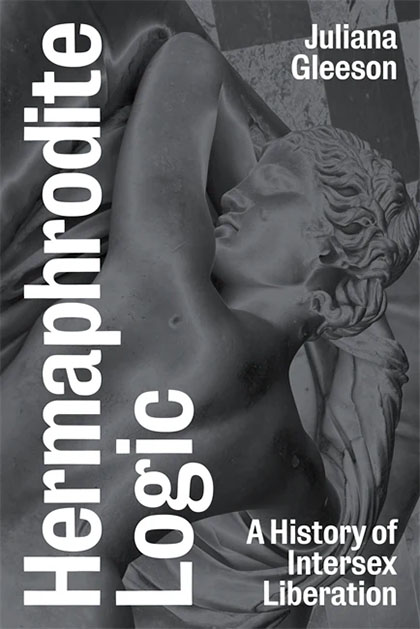Critical Inquiry Critical Inquiry
Juliana Gleeson. Hermaphrodite Logic: A History of Intersex Liberation. New York: Verso Books, 2025. 256 pp.
Review by Eva Pensis
5 September 2025
Following the Minneapolis school shooting on 27 August, a spatter of stories broke alleging a connection between the perpetrator’s gender identity and their propensity for mass murder. According to Department of Homeland Security Secretary Kristi Noem, Robin Westman, “the deranged monster,” was “transgender.”[1] Despite the Minneapolis mayor’s televised warning for people to not speculate on the relation of the shooter’s former transgender identity (Westman had detransitioned prior to the ordeal), multiple media outlets have sought this line of leading questions, hypothesizing an inflammatory correlation between transgender and nonbinary identities and a propensity for endangering children's lives and jeopardizing their futures.
Juliana Gleeson’s recent volume, Hermaphrodite Logic, claims the opposite: that the imagined social order of binary sex is routinely used to justify the institutionalized mutilation of children born with genital variations, once called “intersexual conditions.” A groundbreaking work on the history of intersex organizing, Hermaphrodite Logic asserts that, in truth, children are most frequently threatened not by trigger-happy, nonbinary “monsters” but by medical professionals, clinical practitioners, NGOs, caretakers, and family members.
Insisting on the social as the galvanizing aspect of intersex history, Gleeson tells the story of intersex liberation as a collective form of rationality—one that takes head-on the il-logic upon which the medicalized treatment of intersex people rests. In response to this illogic, Gleeson tracks the evolution of protest, advocacy, and language used, defanging and harnessing clinical, scientific, sexological, and everyday terminology through reclamation, parody, “edginess,” and spoof, for example with the name of the Intersex Society of North America’s (ISNA) quarterly publication, Hermaphrodites with Attitude, an appropriation of the Compton-based hip hop group NWA to which I’ll return shortly (p. 30).
Across the book’s archive, caretakers and medics alike insist on surgical interventions to nullify the threat of children’s so-called abnormal or disordered sexual development. Rarely do these procedures result in a quality-of-life improvement, though: “[r]ather than preventing harm, they caused lifelong numbness” (p. 18). The procedures, according to the doctors, grant the intersex child a future within a (cis-)heterosexist world. The relation of futurity to “normal” sexual development came to play a major role in how early intersex advocacy reframed the experience of clinical violence: surgical interventions instead served to medicalize the “psychosocial crisis” that intersex posed for medics and caregivers (p. 43). Gleeson’s intersex history demonstrates that the cost of maintaining the fiction of binary sex is the routinized harm and mutilation of children who fail to measure up to its fictive promise.
Between the first and second installments of their quarterly publication, the ISNA made one seemingly minor change: it dropped an s. The publication's inaugural issue was printed under the title Hermaphrodites with Attitudes. When it appeared the following summer, the title’s “attitude” was now singularized—corrected true to form to copy the Compton-based rap group’s name. To Gleeson, the journal’s title paid homage to the rap group, one of several “nineties edgy . . . rhetorical strategies” that characterized early intersex advocacy and enabled HWA to mock and satirize those who had exercised power against youth with intersex variations (p. 33). Still—the titular excision of s between the first and second issues suggests a certain unfamiliarity with the reference’s source material, underscoring what Lauren Michele Jackson identifies as a key tenet of cultural appropriation: “Everybody wants the insurgence of blackness with the wealth of whiteness.”[2] In a later section, Gleeson turns to W. E. B. Du Bois’s theory of double consciousness to describe the paradigmatic experience of being “known over” for intersex children, where their own knowledge and experience of their bodies is subjugated to the folk expertise of clinical professionals (p. 1). I found the turn to Du Bois’s sociological theory puzzling not for its explanatory power but rather in the application of a theory of racial difference to one of sex, not unlike the ISNA’s nominal gesture to NWA that imbued the newsletter with the cultural capital of “edginess.”
In both instances, intersexual difference is theorized with recourse to sites and ideas central to the study of African American life—namely, the veil of anti-Black racism and the “regional specificity” of NWA’s “facets of black marginality”—a characteristic that raises critical questions about what commonalities ISNA imagined itself to share with the rap group and broader hip-hop culture, not to mention what connections exist between intersex organizing and Black liberation movements more generally.[3] Why the recourse to Black social thought and cultural production to make sense of intersex experiences? These questions remain un(der)examined throughout.
Because Gleeson stresses the social as the locus of intersex liberation, it seems even more apropos to attend to the contradictions and inequities that inhere the social and the uneven conceptual terrain of the human. Still, in a chapter concerned with sex testing in sports across the African continent, there remains more to be unpacked about the problem that race poses to intersex theory (to borrow Zine Magubane’s adaptation of Barbara Christian’s insight).[4] This foundational problem raises questions about intersex liberation’s local and global relation to racial histories of the production of sex—trans identity, gynecology, infanticide, and disability to name a few—that might productively complicate and qualify what exactly counts as Hermaphrodite Logic.
[1] Kristi Noem, Twitter, 27 Aug. 2025.
[2] Lauren Michele Jackson, White Negroes: When Cornrows Were in Vogue . . . and Other Thoughts on Cultural Appropriation (Boston, 2019), p. 6.
[3] Tricia Rose describes gangsta rap as a genre of hip-hop music that often captures “the regional specificity of spatial, ethnic, temperate, and psychological facets of black marginality in Los Angeles” (Tricia Rose, Black Noise: Rap Music and Black Culture in Contemporary America [Middletown, Conn., 1994], p. 11).
[4] See Zine Magubane, “Spectacles and Scholarship: Caster Semenya, Intersex Studies, and the Problem of Race in Feminist Theory,” Signs 39 (Spring 2014): 761–85.

